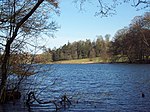West Tisbury, Wiltshire

West Tisbury is a civil parish in southwest Wiltshire, England. The parish takes in the southwestern quarter of the village of Tisbury and extends about 3.8 miles (6.1 km) westward; Tisbury is about 13 miles (21 km) west of Salisbury. The settlements in the parish are the following hamlets: East Hatch Kinghay Newtown Tuckingmill, immediately west of Tisbury (not to be confused with Tuckingmill, Cornwall or Tucking Mill, Somerset) West Hatch (not to be confused with West Hatch civil parish, Somerset)The River Sem, a tributary of the Nadder, forms almost all of the southern boundary of the parish. The West of England Main Line railway, opened in 1859, follows the same route. The civil parish elects a parish council. It is in the area of Wiltshire Council unitary authority, which is responsible for all significant local government functions.
Excerpt from the Wikipedia article West Tisbury, Wiltshire (License: CC BY-SA 3.0, Authors, Images).West Tisbury, Wiltshire
Geographical coordinates (GPS) Address Nearby Places Show on map
Geographical coordinates (GPS)
| Latitude | Longitude |
|---|---|
| N 51.06 ° | E -2.12 ° |
Address
SP3 6NX , West Tisbury
England, United Kingdom
Open on Google Maps









